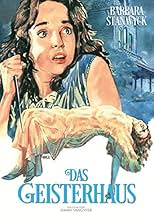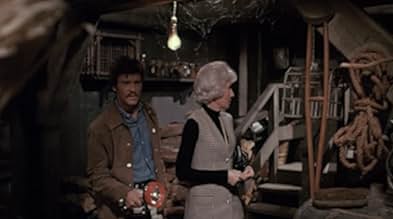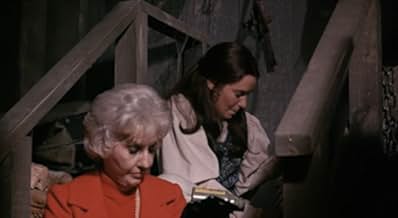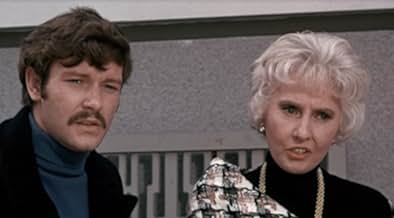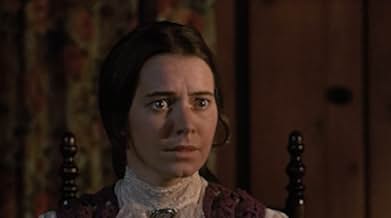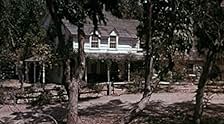NOTE IMDb
5,6/10
1,2 k
MA NOTE
Ajouter une intrigue dans votre langueA woman and her niece move into an ancestral house in the Amish countryside haunted by two ghosts from the Revolutionary War.A woman and her niece move into an ancestral house in the Amish countryside haunted by two ghosts from the Revolutionary War.A woman and her niece move into an ancestral house in the Amish countryside haunted by two ghosts from the Revolutionary War.
- Réalisation
- Scénario
- Casting principal
Avis à la une
Barbara Stanwyck stars in this curious ghost story, produced for television by Aaron Spelling. She plays a secretary who, along with her college-age niece, moves into an old country estate she inherited from her hermit cousin...but an eerie, malevolent force presides in the house, and a spirit is unleashed (perhaps by a séance) that overtakes the girl. Henry Farrell adapted this teleplay from Barbara Michaels' novel, "Ammie, Come Home", which is rather top-heavy with wind-machine effects and centuries-old discoveries in dark rooms. The plot is laid out in a connect-the-dots fashion which mitigates against real suspense, although Richard Egan is scarily intense whenever his professor becomes possessed by a murderer. The young woman is played by a debuting Katherine Winn who, three years later (as Kitty Winn), dealt with possession and exorcism again as a cast member of "The Exorcist". Stanwyck is disappointing--she pretty much walks through this one--but Egan is a good romantic match for her and the finale is tied-up well.
The House That Would Not Die is a solid TV-film that could have been stronger had screenwriters stuck closer to Barbara Michael's excellent supernatural suspense novel, "Ammie, Come Home." Michael's story is set in Washington, D.C.; Ruth, a Department of Commerce official, has lived in a Georgetown row house for some years after inheriting it from a distant cousin. There is no ghostly presence until Ruth's niece Sara moves in with her to attend a nearby university. Sara first hears a voice in the night calling "Ammie, come home," but aunt & niece decide it's a neighbor calling a lost pet. When Ruth meets one of Sara's professors, the adventurous son of a famous Washington hostess (a character based on Marjorie Merriwether Post), the ghostly presences intensify & become violent. By using entries in the family Bible and searching old newspapers & archives, the 4 major characters (Ruth, the professor--who becomes her love interest--Sara & her boyfriend) piece together the tragic tale of the house's original builder & his daughter, Amanda. During the Revolution, Amanda's father was a royalist but Amanda fell in love with a young officer in the American army. When her father discovered they were about to elope, he killed them & buried the bodies in the basement of his house. He lived there as a recluse until he was killed when the house burned. Relatives (Ruth's ancestors) inherited the land & built a new house, never knowing what had happened. After young Sara moved in, the spirits of Amanda & her father began to re-enact their tragedy endlessly. It is the disembodied voice of Amanda's lover calling, "Ammie, come home."
Why the writers moved the film to Amish country in Pennsylvania is a mystery, unless they figured in 1970 Washington had enough problems & didn't need any more ghosts. Having Ruth occupy the house only as the film begins robs the novel's story line of a major point: that Ruth had lived there for some years with no sign of supernatural activity. The sudden appearance of a voice crying in the night is, in the novel, an unexpected, vaguely ominous occurrence,which Ruth & Sara assume is a neighbor. That there are neighbors in Georgetown highlights a second point in the novel that is weakened by the shift to Pennsylvania: a setting in highly civilized, urbane Georgetown makes supernatural events seem even more incongruous with everyday life than the film's rural setting in Pennsylvania, where the house's isolation, like Hill House in "The Haunting," seems to invite every ghost within shouting distance. (Why are these houses always 'way out in the country?)
Despite inferior adaptation from the novel, performances & production values in The House That Would Not Die are exceptional in every way. Stanwyck & Egan are physically perfect for the characters described in "Ammie, Come Home." As the at-times-possessed Sara, Wynn must portray not only that modern young woman but the long-dead Amanda too, and she does a very solid job. Her boyfriend is portrayed by Michael Anderson Jr., who does not resemble the tall, slim, dark character in Michael's novel, but plays the role well. All things considered, this is a worthwhile TV-film that will repay a viewing. But don't deny yourself the chance to read the book.
Why the writers moved the film to Amish country in Pennsylvania is a mystery, unless they figured in 1970 Washington had enough problems & didn't need any more ghosts. Having Ruth occupy the house only as the film begins robs the novel's story line of a major point: that Ruth had lived there for some years with no sign of supernatural activity. The sudden appearance of a voice crying in the night is, in the novel, an unexpected, vaguely ominous occurrence,which Ruth & Sara assume is a neighbor. That there are neighbors in Georgetown highlights a second point in the novel that is weakened by the shift to Pennsylvania: a setting in highly civilized, urbane Georgetown makes supernatural events seem even more incongruous with everyday life than the film's rural setting in Pennsylvania, where the house's isolation, like Hill House in "The Haunting," seems to invite every ghost within shouting distance. (Why are these houses always 'way out in the country?)
Despite inferior adaptation from the novel, performances & production values in The House That Would Not Die are exceptional in every way. Stanwyck & Egan are physically perfect for the characters described in "Ammie, Come Home." As the at-times-possessed Sara, Wynn must portray not only that modern young woman but the long-dead Amanda too, and she does a very solid job. Her boyfriend is portrayed by Michael Anderson Jr., who does not resemble the tall, slim, dark character in Michael's novel, but plays the role well. All things considered, this is a worthwhile TV-film that will repay a viewing. But don't deny yourself the chance to read the book.
Somewhat uneven and even at only 80 minutes begins to outstay its welcome. But I don't wish to be too harsh for there is a marvellous performance by Barbara Stanwyck which helps to hold this together and if only Richard Egan could have been half as good this might have a been a great picture. It's a TV movie with minimal budget but even without special effects the possession scenes are most effective.
This starts as a haunted house movie but swiftly moves into the possession business and in these scenes Egan acquits himself well and Kitty Winn (who would have a role in The Exorcist three years later) is particularly good and indeed is the main reason for those shivers down the spine more than once during this modest but successful little film.
This starts as a haunted house movie but swiftly moves into the possession business and in these scenes Egan acquits himself well and Kitty Winn (who would have a role in The Exorcist three years later) is particularly good and indeed is the main reason for those shivers down the spine more than once during this modest but successful little film.
10Phill-13
The house That Would Not Die is one of the all-time great ghost stories ever filmed. In fact, the only thing wrong about it is that it's total running time was only about 75 minutes to fit into a 90-minute time slot. It should have been a full ninety minutes or longer and released to theaters. Ruth Bennett (played by the great Barbara Stanwyck who hands off scene after scene to her younger co-stars to let them shine in their own right) inherits a centuries-old house built before the Revolutionary War, in the Amish Country of Pennsylvania. The original owner, General Douglas Campbell, was suspected of collaborating with the British during the war. His daughter, Amanda (Ammie) and her boyfriend, American Soldier Anthony Doyle, confront him, and they disappear shortly after, ostensibly eloping. For the rest of his life, Old General Campbell roams the countryside calling: "Ammie, come home!", a cry heard two hundred years later by Stanwyck and her young niece, Sara Dunning (played by the pretty and very talented Kitty Wynn, after they move into the house. Aided by Stan Whitman (played by Michael Anderson, Jr., another very talented actor), and Professor Pat McDougal (played by another great actor, Richard Egan) they endeavor to discover the reason why the general is still searching for his long-lost daughter after two hundred years. The resolution and climax of this exciting ghost story will have one and all riveted to the edge of their seats, especially if properly viewed at midnight, Saturday night, during a thunderstorm with howling winds and crashing thunder.
As any fan of classic film and cheeseball TV knows, Barbara Stanwyck was one durable dame. The woman who conquered the corporate world in 1933's "Baby Face" and blasted gun-toting outlaws on "The Big Valley" is more than a match for the wind machines and bad actors who challenge her in this cheapo 1970 made-for, which is why it's ultimately not that scary or suspenseful. It's also hampered by a cobwebbed ghost story plot -- a maiden aunt and her dewy young niece move into an old house only to learn (oh no!) that it's haunted. Still, it's always fun to hang out with Babs, so "The House that Wouldn't Die" isn't a complete waste of time. It's like decaffeinated coffee, a short, mild indulgence that won't keep you awake at night.
Miss Stanwyck plays Ruth, a career Washington bureaucrat who takes a sabbatical (Civil Service rules must have been a lot more relaxed during the Nixon administration) and moves to a late distant relative's house near where her fluttery niece Sarah, played by Kitty Wynn, plans to attend college. If Stanwyck is above this sort of downmarket Gothic, Wynn is perfect for it since she seems born to play wide-eyed, helpless young ingénues -- the only time her voice rises above a quivering whisper is when she screams, which she does enough to wake the dead. The dead, however, don't seem to appreciate the intrusion so they start possessing various characters and making them act homicidal. Having apparently exhausted the budget on Babs' salary and nifty wardrobe (the cranberry pantsuit she dons toward the end of the flick is particularly chic), the producers could only afford a single special effect -- a megawatt wind machine which gets switched onto high every time one of the undead makes an appearance. This motif is a bit too indicative, but it's also the only way you'll know that Richard Egan, who plays Babs' romantic interest, has transformed from gentlemanly anthropology professor next door to malevolent spirit. His facial expression doesn't change otherwise. Rounding out this intrepid quartet is someone named Michael Anderson Jr. as Professor Egan's swishy grad student and Kitty's chaste love interest. The movie could be unwatchably dull but isn't, thanks to Babs' stalwart presence. However, it could be atmospherically creepy but isn't, thanks to Egan's granite stiffness and a script that sounds like it was penned by the "Scooby Doo" staff during a prime time writers' strike ("try and open up this old writing desk . . . these things are usually crammed with old letters and papers" declares Babs, perhaps unaware that she's channeling Velma Dinkley). Still, Miss Barbara Stanwyck offers a primer on how to maintain your dignity during the twilight of your career. Someone should have forced Bette Davis to watch this movie.
Miss Stanwyck plays Ruth, a career Washington bureaucrat who takes a sabbatical (Civil Service rules must have been a lot more relaxed during the Nixon administration) and moves to a late distant relative's house near where her fluttery niece Sarah, played by Kitty Wynn, plans to attend college. If Stanwyck is above this sort of downmarket Gothic, Wynn is perfect for it since she seems born to play wide-eyed, helpless young ingénues -- the only time her voice rises above a quivering whisper is when she screams, which she does enough to wake the dead. The dead, however, don't seem to appreciate the intrusion so they start possessing various characters and making them act homicidal. Having apparently exhausted the budget on Babs' salary and nifty wardrobe (the cranberry pantsuit she dons toward the end of the flick is particularly chic), the producers could only afford a single special effect -- a megawatt wind machine which gets switched onto high every time one of the undead makes an appearance. This motif is a bit too indicative, but it's also the only way you'll know that Richard Egan, who plays Babs' romantic interest, has transformed from gentlemanly anthropology professor next door to malevolent spirit. His facial expression doesn't change otherwise. Rounding out this intrepid quartet is someone named Michael Anderson Jr. as Professor Egan's swishy grad student and Kitty's chaste love interest. The movie could be unwatchably dull but isn't, thanks to Babs' stalwart presence. However, it could be atmospherically creepy but isn't, thanks to Egan's granite stiffness and a script that sounds like it was penned by the "Scooby Doo" staff during a prime time writers' strike ("try and open up this old writing desk . . . these things are usually crammed with old letters and papers" declares Babs, perhaps unaware that she's channeling Velma Dinkley). Still, Miss Barbara Stanwyck offers a primer on how to maintain your dignity during the twilight of your career. Someone should have forced Bette Davis to watch this movie.
Le saviez-vous
- AnecdotesThe German poster features an image of Jessica Harper from Suspiria (1977).
- GaffesA boom mic is briefly visible on the windshield of Richard Egan's car when he meets Barbara Stanwyck and Michael Anderson Jr. outside the Hall of Records.
- ConnexionsFeatured in Elvira's Halloween Movie Schlock-A-Thon (1993)
Meilleurs choix
Connectez-vous pour évaluer et suivre la liste de favoris afin de recevoir des recommandations personnalisées
Détails
Contribuer à cette page
Suggérer une modification ou ajouter du contenu manquant

